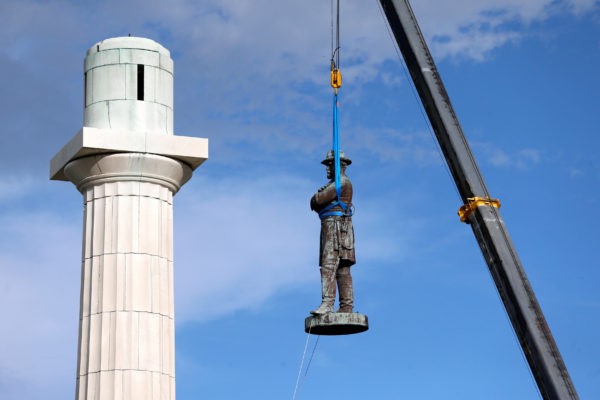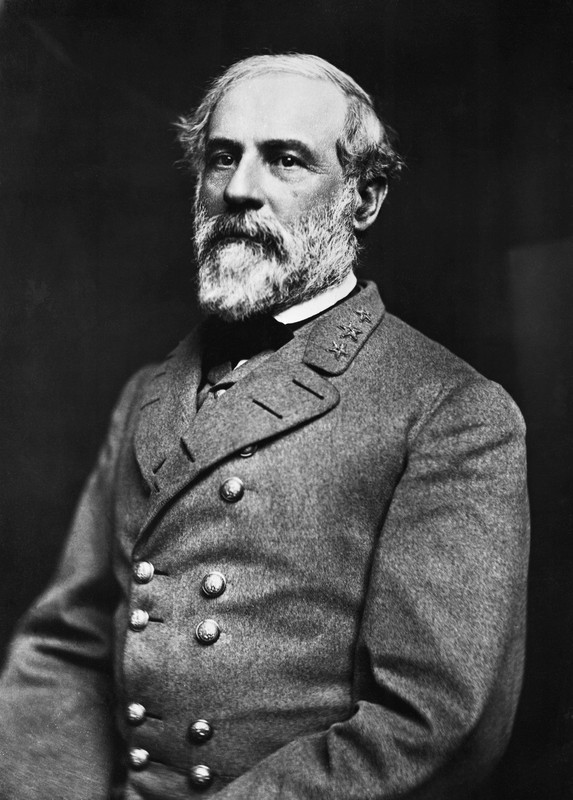Robert E. Lee Monument in New Orleans (1884-2017)
Introduction
Text-to-speech Audio
The Robert E. Lee monument in New Orleans, Louisiana was created in 1884 by the Robert E. Lee Monumental Association to memorialize the military leader of the Confederate Army during the American Civil War. Residents and visitors to the city increasingly questioned the propriety of a monument honoring the leader of the Confederate military which culminated in city leaders deciding to remove the monument on May 19, 2017.
Images
The Robert E. Lee Monument being removed on May 19, 2017 in New Orleans, Louisiana.

Confederate Military General Robert E. Lee.

Backstory and Context
Text-to-speech Audio
Robert E. Lee was a general of the Confederate Army during the American Civil War from 1861 to 1865. He led the Army of Northern Virginia from June 1861 until the end of the war. Lee led his army through the war and was known both for a series of tactical decisions that helped his armies evade or defeat superior United States forces and also the questionable decision to twice invade Northern states which resulted in two major turning points of the war. Lee surrendered in April 1865 and died on October 12, 1870.
The Robert E. Lee statue was created in 1884 by the Robert E. Lee Monumental Association. The monument was removed on May 19, 2017, by the city of New Orleans, Louisiana. A crowd of spectators gathered to watch the statue be removed from the heavily trafficked area. The contractors who were hired to remove the Confederate monuments had received threats for removing the monuments. The New Orleans Mayor Landrieu’s office said the removal of the landmarks was paid for through private funding by the city.
The Lee monument was originally made to memorialize his efforts as a Confederate general during the American Civil War. The United Daughters of the Confederacy was founded in Nashville, Tennessee on September 10, 1894, by Mrs. Caroline Meriwether Goodlett from Tennessee and Mrs. Lucian H. (Anna Davenport) Raines from Georgia. The UDC was created to memorialize and vindicate the Antebellum South through memorials and monuments. For over a century, the organization has worked to minimize the South's connection to slavery while presenting an alternative version of history that suggests the Civil War was about state's rights. In reality, Southern states opposed state's rights whenever Northern or Western states sought to support the freedom of former slaves as demonstrated in the court case Prigg v. Pennsylvania. They also opposed a state or territory's right to make laws preventing slavery as was demonstrated in Kansas in the years leading up to the Civil War.
The Robert E. Lee monument was one of four Confederate monuments the New Orleans mayor removed in 2017. The statues are now stored in an undisclosed location. After the Robert E. Lee monument was removed, other cities across the country removed their Confederate monuments and statues.
Lee himself opposed Confederate monuments after the Civil War. Lee is quoted in a letter to Thoms L. Rosser saying he believes Confederate monuments wouldn't aid in the nation's progression and healing after the war. The full statement from the letter is below.
"As regards the erection of such a monument as is contemplated; my conviction is, that however grateful it would be to the feelings of the South, the attempt in the present condition of the Country, would have the effect of retarding, instead of accelerating its accomplishment; & of continuing, if not adding to, the difficulties under which the Southern people labour. All I think that can now be done, is to aid our noble & generous women in their efforts to protect the graves & mark the last resting places of those who have fallen, & wait for better times".6
Sources
1. Gonzales, Richard, Held, Amy. New Orleans Takes Down Statue Of Gen. Robert E. Lee. National Public Radio. May 19, 2017. Accessed September 05, 2018. https://www.npr.org/sections/thetwo-way/2017/05/19/529130606/new-orleans-prepares-to-take-down-statu....
2. Farmer, Brit. Behind the decision to remove a statue of Robert E. Lee. 60 Minutes Overtime. July 15, 2018. Accessed September 06, 2018. https://www.cbsnews.com/news/60-minutes-behind-the-decision-to-remove-a-statue-of-robert-e-lee/.
3. Simons, Darran, Almasy, Steve. Final Confederate statue comes down in New Orleans. CNN. May 19, 2017. Accessed September 05, 2018. https://www.cnn.com/2017/05/19/us/new-orleans-Confederate-monuments/index.html.
4. Robert E. Lee. History.com. . Accessed September 06, 2018. https://www.history.com/topics/american-civil-war/robert-e-lee.
5. Reuters. Bangor Daily News, Bangor Daily News, May 19, 2017, https://bangordailynews.com/2017/05/20/news/nation/new-orleans-removes-statue-of-gen-robert-e-lee/.
6. Lee, Robert E.. Lee Family Digital Archive. December 13, 1866. Accessed September 15, 2018. https://leefamilyarchive.org/papers/letters/transcripts-UVA/v076.html.
7. Nicholson, Amber. Robert E. Lee Monument. New Orleans Historical. . Accessed September 15, 2018. http://www.neworleanshistorical.org/items/show/1279.
8. History of the UDC. United Daughter of the Confederacy. . Accessed September 15, 2018. https://www.hqudc.org/history-of-the-united-daughters-of-the-confederacy/.
9. Bettmann / Getty. New Yorker, Getty Images, https://www.newyorker.com/news/news-desk/what-is-it-like-to-be-a-Black-student-at-robert-e-lee-high-...
